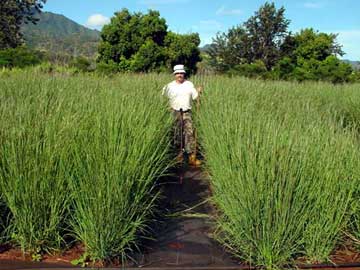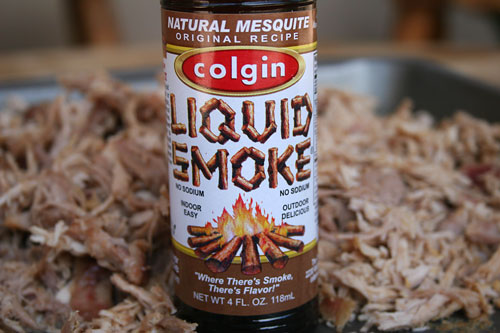(As an aside, I wrote this before I read Jeff’s Oct. 13 post so don’t read this as a rebuttal!)
One of the hallmarks of science is that it pays to keep an open mind. We all tend to have biases so it’s good to get a reminder once in a while that some things that seem ‘out there’ can actually work and provide some useful information.
A case in point. At the American Society for Horticultural Sciences annual meetings I make a point to wonder through and browse all of the poster presentations – even those that appear to have little relevance to issues I typically deal with. This year one of the posters that caught my eye was by Orville Baldos and his colleagues at the University of Hawaii and the USDA on the use of liquid smoke flavoring to improve seed germination of piligrass.
So first, what’s piligrass and why would you want to improve its seed germination? Piligrass is a native bunchgrass in Hawaii. It’s used for conservation and restoration projects and there is increased interested in its use as an ornamental. It is drought tolerant and fire adapted but production is limited by poor seed germination. Where does liquid smoke flavoring come in? Liquid smoke is produced by passing wood smoke through water (I assume someone somewhere has constructed the world’s largest bong to accomplish this). The water traps a variety of chemical compounds in solution, many of which are useful in giving a delicious smoky flavor to foods that have never been near a grill. Some of the compounds in liquid smoke are also useful in improving germination of seeds of fire adapted plants, or at least piligrass.

In their study Baldos et al. found that germination of piligrass seeds soaked in distilled water was a paltry 0.5%. In other words, you’d have to sow 200 seeds for each plant you hoped to produce. Soaking seeds in gibberillic acid (a common method to improve seed germination for a variety of plants) bumped the germination rate up to 20% (5 seeds to get one plant). But soaking seeds in liquid smoke did better still and doubled the germination to 40%.

At the end of the day it’s unlikely that I’ll ever use liquid smoke for anything except adding a little extra zing to my family’s secret barbeque sauce. But this study is a good example that sometimes things that make you go ‘What the heck?’ can have merit in the end. Just need to take a scientific approach and keep an open mind.
For those interested in the details here’s a link to the poster http://ashs.org/abstracts/sites/default/files/updated_ashs_poster_091911.pdf
I wonder how they first came up with the idea….
Some mechanisms of fire-adapted speceis are physical (e.g. thick bark, serotenous cones) but some are chemical. I saw a presentation a few years ago by some Australian researchers using ‘smoke water’ to enhance germination. The idea is that there are compounds in smoke that serve a
s a trigger to overcome dormancy in seeds of fire-adapted species. The beauty of using the commercial ‘Liquid Smoke’ is that nurseries have a consistent, readily available source, rather than having to produce their own smoke water each time.
Interesting post, Bert!
It’s good they’ve found a good use for liquid smoke since as a food additive it can be bad. I’ll use it occasionally in a marinade, but it’s very easy to overuse it and destroy a perfectly good piece of meat. There’s nothing like a real smoky flavor.
But liquid smoke *is* real smoky flavor – it’s smoke trapped in water that is then distilled. You can even make your own.
Aloha! I came across the idea when a professor of mine gave me an article on American Nurseryman about germination enhancement using liquid smoke. During that time, I was developing my dissertation proposal on piligrass involving seed production and treatments to break dormancy. Gibberellic acid is listed in the literature as an effective treatment to break dormancy in piligrass. However, it is very expensive and not widely available. I thought liquid smoke flavoring can be a cheaper and more accessible alternative so that’s why I tried it (and it turned out to be pretty effective!). Additional readings/research has lead to a number of articles on smoke and germination. I have found more than 40 journal articles and counting (including two published papers describing the germination enhancement using liquid smoke flavoring). Most of the studies have been conducted either in South Africa and Australia. About 7 years ago, an Austrialian scientist was able to isolate the active compound responsible for enhancing germination. It is called karrikinolide (named after an aboriginal Australian word for smoke: karrik). I have yet to test this compound on my study species.
So I realize this is an old post, but the blog here appears to be recently updated and we’ll maintained, so I thought I would chime in here just looking to get a few thoughts from some folks that clearly know much more than I do…. let me start by saying I’m a project manager by trade (if you can even call that a trade), but do a good amount of gardening and otherwise “tinkering” with the little chunk of suburbia that I call my own.
I’ll try to keep the “how I found this thread” part short, but some of that is veryour relevant to my broader question(s)/comments, so here is the long and short of it. Stay with me here, I promise it’s coming back to the thread :D…. I’ve put a great deal of work into my lawn here, as well as 4 different “medium size” gardens ive planted in various locations around a lot just over a half acre, and then a few corner patches and such with a random tomato plants or berry bush (taking advantage of better sunlight at different times of year and making the best of the space I have). I noticed over the last year or so, that urine spots from my dogs had gotten increasingly worse and the lawn seemingly more susceptible to thesee spots as nothing had changed with the dogs diet, routine etc. So I started researching a bit to understand the issue with Urine and plants specifically. Having some basic knowledge around the process of photosynthesis, needed components for it to work, and plant care/gardening in general, it wasn’t a shocker to find high nitrogen concentrates I’m urine don’t mix well with grass. That said, I guess I assumed there was more to it than just nitrogen burn. I mulled on this for while and started paying closer attention to other things with my garden (s) and other ornamental plants around my property. Taking this closer look and making some daily notes for myself, i came to the conclusion that the soil around my property seems to be quite high in nitrogen. I bought a basic soil test kit and took a few random samples which seem to support that theory.
Now that this (at least in my mind) had become more than a case of “my lawn looks like crap”, and I saw an opportunity for better yield and an overall healthier garden/lawn in general, I wanted to dig in more. I figured if it’s just a nitrogen problem, surely I can do some thing both naturally and on a small scale “localized basis” (urine spots, plants having more trouble than others etc) and started researching. After a lot of posts around usingredients sawdust, wood chips and other sugar water, all of course being high in carbons, to soak up the excess nitrogen, I found a feway threads that suggested different mixtures of chlorinated water and “wood vinegar” (some also had fish amino acids and all kinds of other off the wall stuff, but all had “wood vinegar”). After some research, I found this unknown substance (at least to me) to be Pyroligneous Acid, also known as wood acid. And from what I can tell, it’s the exact same thing as liquid smoke….
So I guess that in part, I’m just throwing some of this out here for general comments/thoughts. But given that there is some really good, and really detailed information elsewhere on this site thato is clearly coming from some very knowledgeable folks, I was also hoping maybe someone could answer a few questions for me. Perhaps the innovative approach to using the liquid smoke for germination, and not root growth or soil balance was the real find in this article. Most, if not all of my observations and findings above may be old hat for this group, but I thought it worth a reply anyhow. Really appreciate any feedback. Here are my questions:
Does anyone know if liquid smoke is in fact the same thing as “wood vinegar”/Pyroligneous acid? And has anyone had any experience in using it to offset high nitrogen levels (or any other apllicatione for that matter)
If there has been success with this, does the type of wood used during the process of creating the wood vinegar make a difference? I read that the final product contains hundreds of travel organic materials, and wasn’t sure if one wood may provide more of those than another as I have to assume those help the soil balance long term more than the carbons??
Last, if anyone has any other clever and not so obvious ways of treating either concentrated patches if too much nitrogen (pet spots) or overall nitrogen excess, I would love to hear them.
Thanks for the great info on the site!